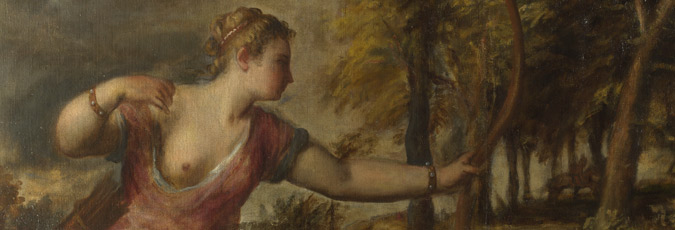The characters of the goddess Diana and the hunter Actaeon in Greek and Roman mythology by Ben Haggarty, International Storyteller
To fully appreciate the mythological story of Diana and Actaeon that inspired Titian, it helps to look into the 'back stories' of each character – Diana and Actaeon both have origins that began many generations before.
Primary sources
You can find classical references to Diana (or Artemis, her Greek name) in literature that covers more than 1,000 years. The most familiar and accessible version of the story of Diana and Actaeon is that given by the Roman poet Ovid (43 BC–AD 17) in his epic work 'Metamorphoses'.
However, a substantially more developed version is given by the Greek writer Nonnus of Panopolis (writing towards the end of the fourth century AD) in his epic 'Dionysiaca'. This work is particularly useful for appreciating who Actaeon is in relationship to Diana, for understanding his lineage and the tragic aftermath of the tale.
Actaeon's father was Aristaeus, a son of Artemis' brother, Apollo. Aristaeus taught human beings the secrets of hunting, trapping, beekeeping, animal husbandry, the cultivation of olives and how to make dairy products.
Diana's birth
Diana's proud and fierce power is best understood by looking at the violence surrounding her birth story – she was born after the god Zeus raped Leto, a beautiful and gentle goddess, who then fell pregnant.
When Zeus' wife, Hera, heard the news, she was seized with a jealous rage and cursed Leto so that no land, sea or any place under the sun would give her a place to rest, preventing her from settling down anywhere to give birth to her twins.
Hera even set monsters in relentless pursuit of Leto, including the great and phallic dragon, the Python.
A place of sanctuary
But help was at hand from Leto's sister Ortygia, who had been turned into a floating island. Ortygia was able to offer Leto sanctuary, as a floating island was neither land nor sea.
Leto was able to give birth to the first of her twins, her daughter, Diana but her second child, Apollo, a boy, caused her huge labour pains.
Hera, realising that Leto had found a way of having her children, prevented the goddess of childbirth Eilithyia, from attending and helping Leto.
New-born babe as midwife
One version of the myth says that the first deed of the new-born Artemis was to become midwife to her mother and over a nine-day, nine-night labour, she brought her brother Apollo into the world.
By looking at the deeds of Artemis in other stories, we gain a sense of who she is and how she acts. By looking at evidence from her rites of worship, we can understand what she represented.
Research
Here are some key stories that are worth researching – they are in an approximate chronological order:
- The rape of Leto by Zeus and his wife Hera's rage
- Leto's pursuit by the Python
- Leto's search for a birthing place
- The birth of Diana and how she was midwife to her brother, Apollo
- The childhood demands Diana made on her father, Zeus
- The capture of the golden-horned deer that pull Artemis' chariot
- The female loves of Artemis
As with much mythology, many of these tales are confused and contradictory, yet they still carry force.
In addition it is worth researching these aspects of Diana's cult:
- Bridal dedications to Artemis
- The cult of childbirth and the offerings on behalf of those who die in childbirth
- The Amazons as followers of Artemis



